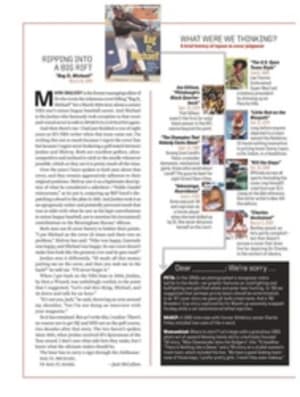
'STRONG-ARMED
NO, I DID NOT audition to be Lance Armstrong's official hagiographer. For five or so years there, during his pharmaceutically enhanced prime, it only seemed that way.
George W. Bush once looked into the eyes of Vladimir Putin and, as he famously put it, "saw his soul." I looked into Armstrong's eyes and saw ... only what I wanted to see.
It was an irresistible story: Cancer survivor cheats death, then dominates the world's most grueling sporting event for seven years, inspiring millions along the way. I wanted very much to believe it. Too much. In 1999, when Armstrong ripped the legs off the best climbers on the planet on the first mountain stage of his first Tour de France victory, Irish sportswriter David Walsh was skeptical. The Texan "climbed with the nonchalance of the well-doped," Walsh later wrote.
I disagreed. I believed that having come so close to death, Armstrong would never risk his health with PEDs. I agreed with TV commentator Paul Sherwen, who after watching a rider never known for his climbing glide away from the best in the world, explained to viewers that cancer had reshaped Armstrong's body, that he'd lost "almost 20 pounds" but none of his power! I saw nothing ridiculous in The New Yorker's explanation, in an effusive 2002 profile, that Armstrong's newfound dominance could be attributed in part to the size of his heart ("almost a third larger than that of an average man") and femurs ("unusually long, which permits him to apply just the right amount of torque to the pedals").
Not that I have room to talk. In 2005 the French newspaper L'Equipe reported that six of Armstrong's urine samples from that 1999 Tour had retroactively tested positive for EPO. In response, I tut-tutted in these pages that the paper had "tried and convicted Armstrong without anything remotely resembling due process."
In fact, they'd turned in a terrific piece of investigative journalism that went against the grain of the narrative I badly wanted to be true. When Armstrong retired, SI produced a special issue celebrating his feats. In that cover story I got the flutters, practically, chronicling the famed F1 Consortium behind Armstrong—a dream team of specialists from Trek and Nike, among others. "When they weren't streamlining Armstrong's kit and rig," I gushed, "it seemed the F1 boys probably could've figured out a way to repair the Hubble telescope." Someone please hose me down.
One year after Armstrong retired, I composed my final cover story on him, a paean to his potential as a crusader who might actually move the needle in the fight against cancer. I quoted Bono and Bill Clinton. Armstrong appeared on the cover with a bunch of cancer-stricken kids and this headline for the accompanying story: "The Next Stage."
The next stage, in fact, was disgrace. Just not right away. One year later I read depositions from a lawsuit filed against Armstrong by a company called SCA Promotions. In those proceedings Betsy Andreu, the wife of ex--Armstrong teammate Frankie Andreu, swore under oath that when a physician asked the Texan if he'd ever used PEDs, Armstrong admitted that he had, blithely rattling off a list of five. Armstrong and his minions dismissed her as embittered, a chronic liar and a head case. Yet when I went to visit the Andreus in Dearborn, Mich., I met a grounded, pleasant woman whose accounts struck me as completely plausible. I wrote as much. Armstrong didn't appreciate that story; he called to let me know.
My coverage of Armstrong was far more skeptical thereafter, though sometimes not enough for Betsy, who once emailed, "I think your yellow bracelet has cut off the supply of oxygen to your brain." (For the record, I never wore a yellow bracelet.)
There was Armstrong in January 2013, contrite in his blue blazer, confessing his PED use to Oprah. This was 11 months after he'd called me to complain about another column. I needed to be more careful, he'd warned. I was talking to the wrong people.
In fact, I wish I'd talked to the Andreus and Greg LeMond much earlier; I wish that I'd seen what Walsh saw way back in 1999: When something looks too good to be true, that's usually because it is.
TEN PHOTOS

